Few people know that in addition to the ancient architecture with a strong Vietnamese style from the Nguyen Dynasty, Hue also boasts a unique European-style palace called An Dinh. With its fascinating European flair and numerous intriguing stories, An Dinh Palace in Hue has been recognized by UNESCO as a world cultural heritage. It has also become a popular destination for many tourists visiting the ancient capital.
Table of Contents
The location of An Dinh Palace in Hue and whether it is difficult to find:
Address of An Dinh Palace Hue
If you’re planning to visit this landmark, you may want to know its location. The palace is situated at 97 Phan Dinh Phung Street, Phu Nhuan Ward, Hue City (formerly part of De Bat Ward, Hue Town). It is located on a flat land, right next to the serene An Cuu River, about 2 km away from the city center.
Directions to An Dinh Palace
Tourists coming from other provinces, international locations, or elsewhere can travel to Hue by various means of transportation and then take a taxi, tour car, or rent a motorbike to visit An Dinh Palace. Since the distance from the city center to the palace is only about 2-3 km, any mode of transportation is convenient. However, if you want more freedom, comfort, and the opportunity to explore many other places, renting a motorbike is still the ideal solution.
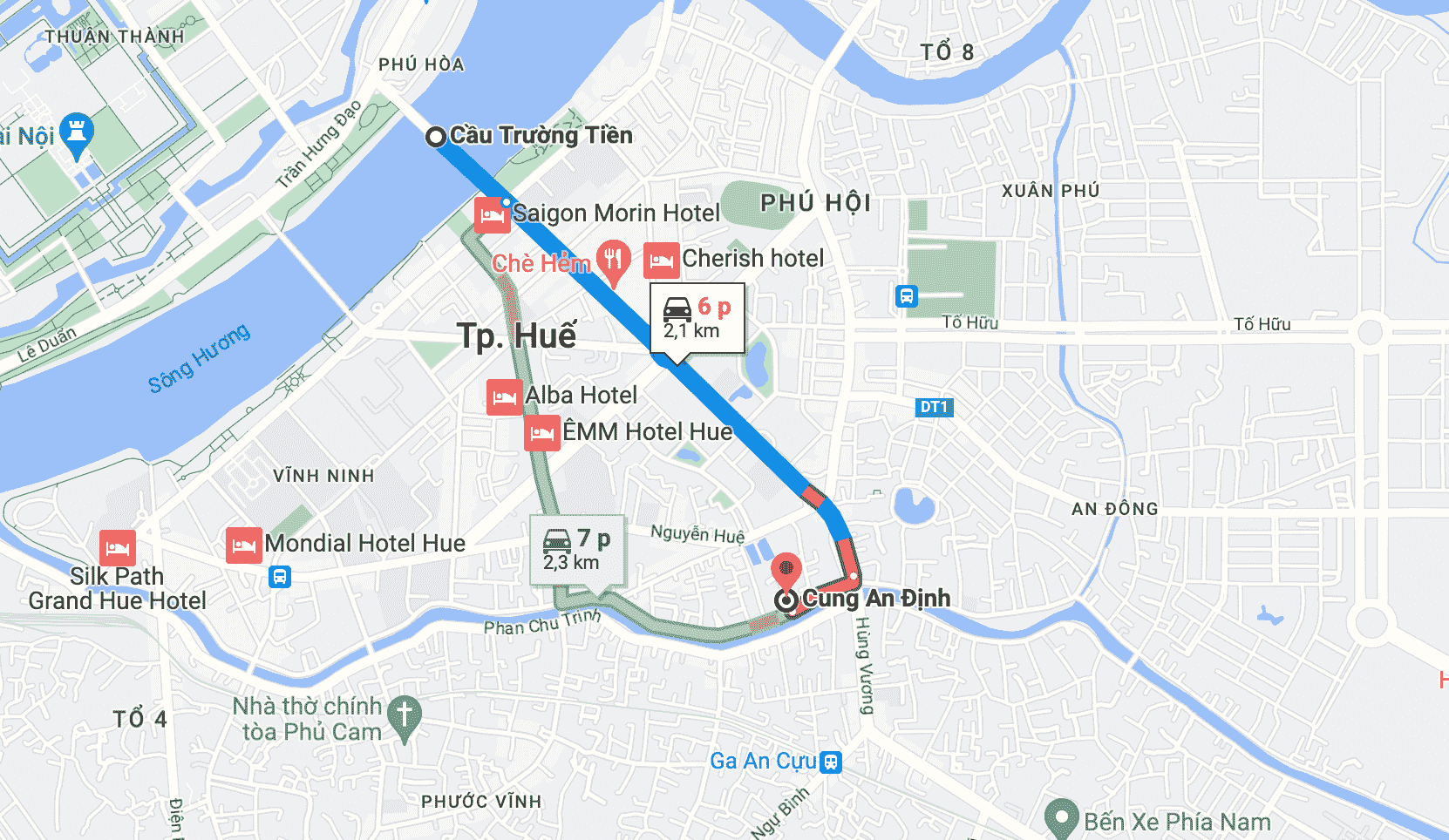
Starting from Trang Tien Bridge – Perfume River, you go straight along Hung Vuong Street. At the intersection, turn right into Phan Dinh Phung Street. After a short distance, you will see a sign indicating An Dinh Palace. You can find parking spaces outside or within the palace area. From there, you can comfortably explore the palace, and it will take you only about 5-10 minutes to get there.
If you want to visit An Dinh Palace and other tourist destinations like Hue Imperial City, Thien Mu Pagoda, etc., choosing a private transportation option is suitable. VnCarRentals’s is a company that provides private car rental services with drivers in Hue. With a team of professional drivers and many years of experience serving international travelers, Vn Car Rentals’s ensures you have the safest and most comfortable journey.
Introduction to the history of the formation of An Dinh Palace:
An Dinh Palace was constructed in 1917 during the reign of King Khai Dinh. Initially (in 1902), this location served as a storage site for the royal belongings. In 1916, Prince Buu Dao ascended the throne and took the regnal name Khai Dinh. After his coronation, he renovated the An Dinh residence and passed it on to Prince Vinh Thuy (who later became King Bao Dai). On the extensive grounds of 23,463 m2, the king ordered the demolition of old structures to begin the construction of new ones. It was during this period that the residence was officially transformed into An Dinh Palace.
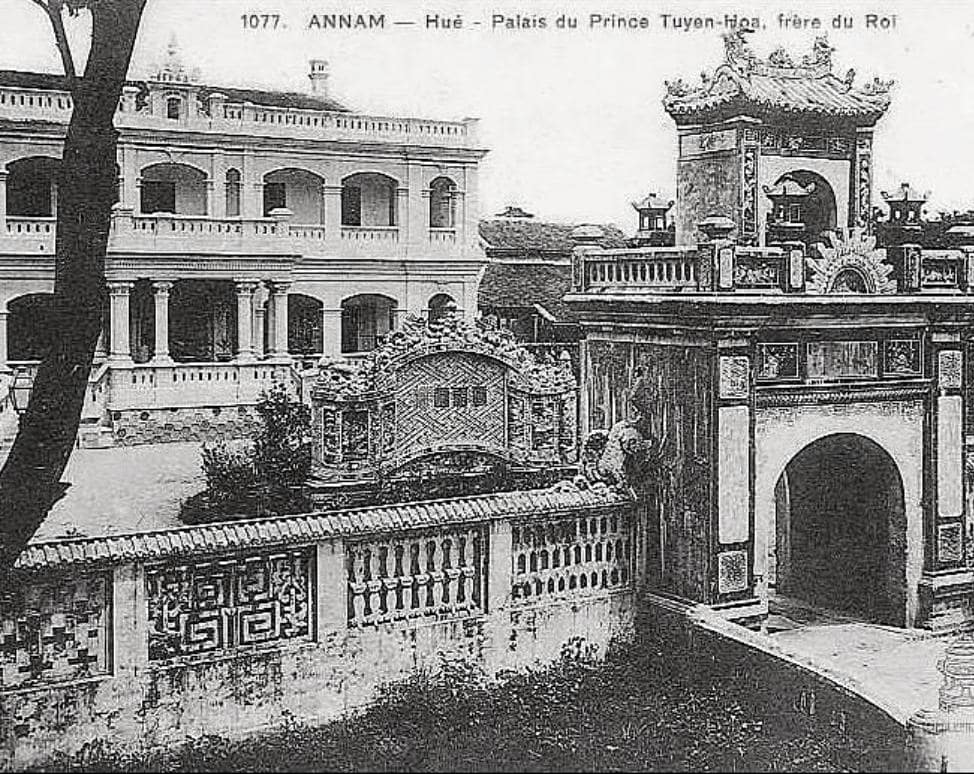
In 1992, Vinh Thuy was carried over to live in the palace. Later, he ascended the throne and took the regnal name Bao Dai. The palace was then passed on to Prince Bao Long. However, after 1945, the entire family of King Bao Dai moved from the Imperial Palace to An Dinh Palace to reside, but it was only for a short period. Only King Bao Dai’s mother, Lady Tu Cung, lived there until 1949.
In 1954, the palace was seized by the regime of Ngo Dinh Diem. After 1975, due to conflicts with the king, Lady Tu Cung decided to hand over the entire palace to the revolutionary government. During this time, the complex was used as communal housing for professors’ families in Hue and served various other purposes. However, due to irregular maintenance, the palace suffered significant damage and deterioration until it was renovated in 2001.
An Dinh Palace in Hue and things you may not know about it.
An Dinh Palace and the fame of Queen Nam Phuong.
From the historical information about An Dinh Palace, we know that this building is associated with many royal figures during the final period of the Nguyen Dynasty. These include King Khai Dinh, King Bao Dai, Prince Bao Long, Queen Doan Huy, and especially Queen Nam Phuong. Her real name was Nguyen Huu Thi Lan, a renowned woman of Annam (Vietnam).
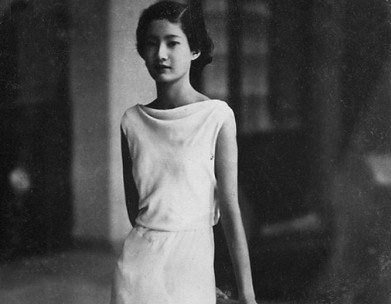
With her noble beauty and compassionate heart, she caught the eye of Bao Dai, and shortly after, she became the queen. However, their marriage went through many ups and downs due to the king’s other relationships. Being an educated and dignified woman, she chose to remain silent, living quietly with her mother-in-law in the palace, taking care of her children. In 1947, she moved to France with her children and settled there.
An Dinh Palace with its unique blend of Eastern and Western architectural beauty.
Compared to other architectural constructions of the time, An Dinh Palace in Hue marked the beginning of a new artistic era for Hue, where Asian and European cultures intertwined in the early 20th century. Most of the decorative details, such as the “tu quy,” “tu linh,” “bat buu,” and the columns, were designed in a sophisticated and elegant European style, with Roman influences.
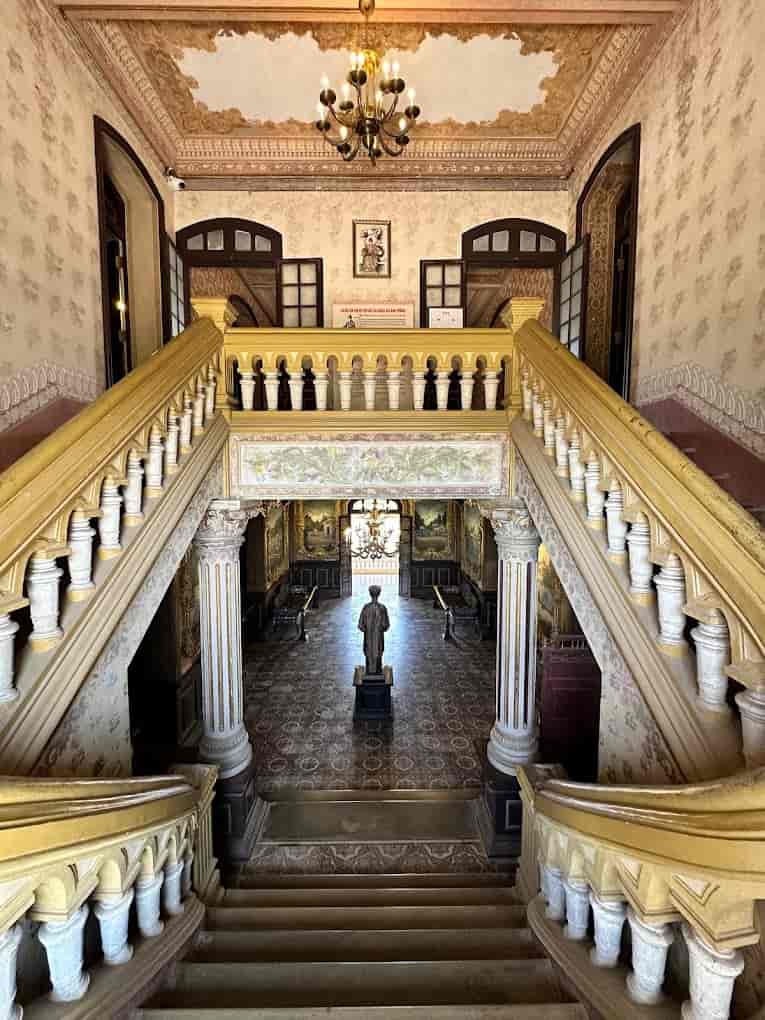
Like many other historical structures, this ancient palace in Hue holds significant value. Although the passage of time has somewhat faded its glory, the palace of King Khai Dinh has left beautiful impressions in the hearts of local people and Vietnamese people in general, as a majestic and modern monument with profound meanings.
An Dinh Palace featured in famous movies and music videos.
If you have seen the movie “Gái già lắm chiêu,” which once caused a sensation in Vietnam, you may recognize An Dinh Palace as the backdrop of the film. In the movie, the palace serves as a luxurious, opulent mansion, isolated from the outside world without phone signals. Its interior carries a strong Western imprint with gold-plated paintings. It also becomes the residence of the Ly family sisters, the main characters in the film.
Not just inside the palace, but also on the vacant land behind the Khai Tuong Pavilion, the film crew built a European-style garden covering an area of 500 m2, with an investment cost of 2 billion VND, called “Bạch Trà Viên.” This is where the Ly family sisters have their tea parties and conversations. After the movie production, the garden was gifted back to Hue for tourism purposes.
Recently, An Dinh Palace in Hue was chosen once again as the filming location for the MV “Không thể cùng nhau suốt kiếp” by the famous Vietnamese singer, Hoa Minzy, delighting Vietnamese youth, especially her fans.
Exploring the detailed architecture of An Dinh Palace | The unique construction of the Nguyen Dynasty.
An Dinh Palace was built facing south, towards the An Cuu River, on flat terrain. It is surrounded by a brick wall measuring 1.8 meters in height and 0.5 meters in thickness, with an iron fence on top. Due to its construction during a period strongly influenced by Western culture, the palace exhibits a harmonious blend of both Eastern and Western architectural styles.
In the past, when it was intact, An Dinh Palace in Hue had around 10 structures (counted from front to back), including Boat Landing, the main gate, Khai Tuong Pavilion, Trung Lap Shrine, a water lake, animal stables, and the Cuu Tu Dai Theater. However, over time and due to the ravages of war, only three structures have managed to preserve their architectural essence.
The Main Gate of An Dinh Palace.
The main gate is considered one of the most remarkable architectural features of the palace. It is designed in a three-door style with two floors, and the details surrounding the gate are adorned with intricate enamelwork, including a large pearl symbol on top of the second floor. Almost the entire gate is decorated with enamel and glass, following unique Vietnamese traditional themes. Even the Han script inscriptions on the gate are made of this material. The main gate has only one passage, and to enter inside, one must pass through this grand entrance.
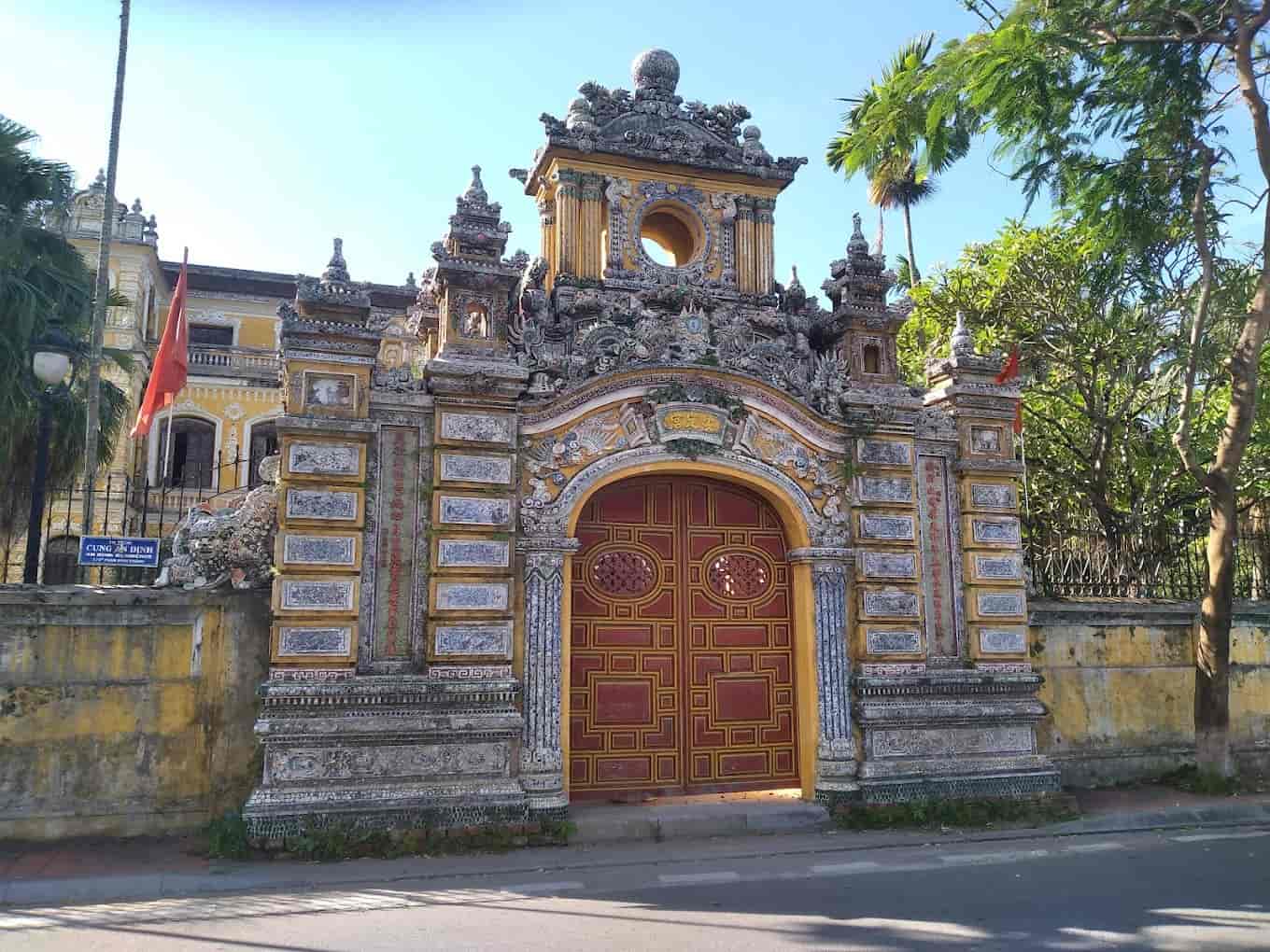
Trung Lap Shrine in An Dinh Palace.
Stepping through the gate, you will encounter the Trung Lap Shrine. It has an octagonal structure with a raised platform. The roof is designed in a two-story style: the lower layer has eight sides, and the upper layer has four sides. Inside the shrine, there is a bronze statue of King Khai Dinh, cast in 1920 with precise proportions, giving it a lifelike appearance. Every detail and ornamentation on the statue is meticulously sculpted and exquisitely crafted.
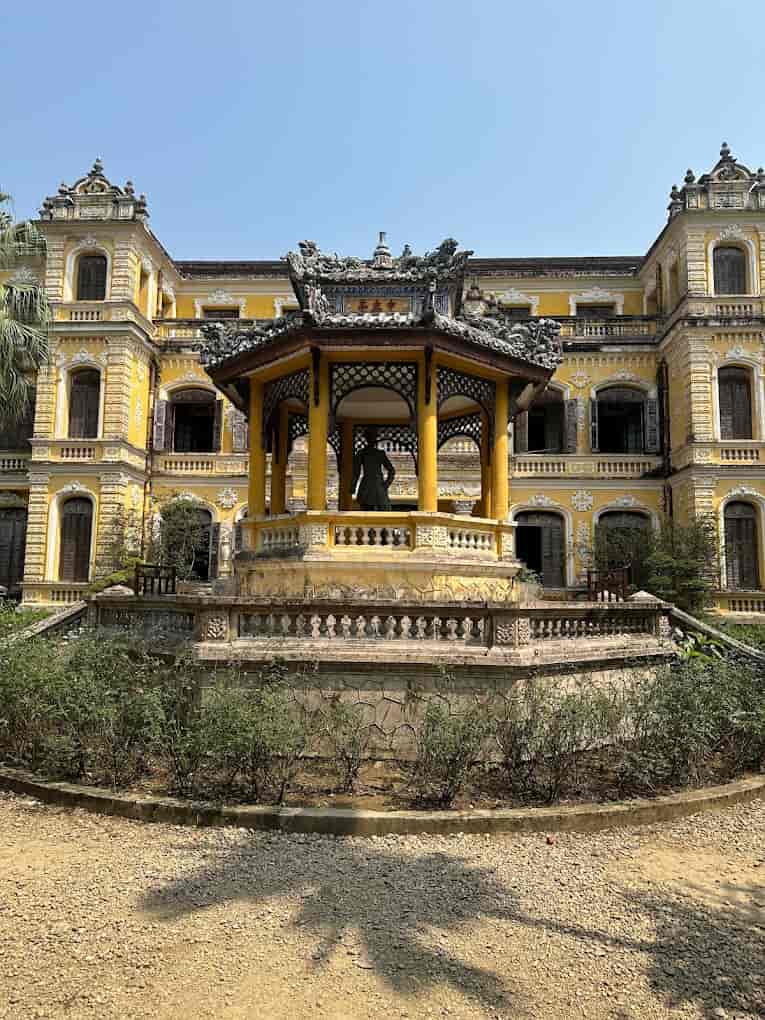
The Main Structure of An Dinh Palace – Khai Tuong Pavilion.
Located behind the Trung Lap Shrine, Khai Tuong Pavilion is the central structure of An Dinh Palace’s architecture. Its name was given by King Khai Dinh, meaning “the place of auspicious beginnings.” The pavilion is divided into three floors, covering an area of about 745 square meters. It is built in the European style, using various materials (some imported from other countries).
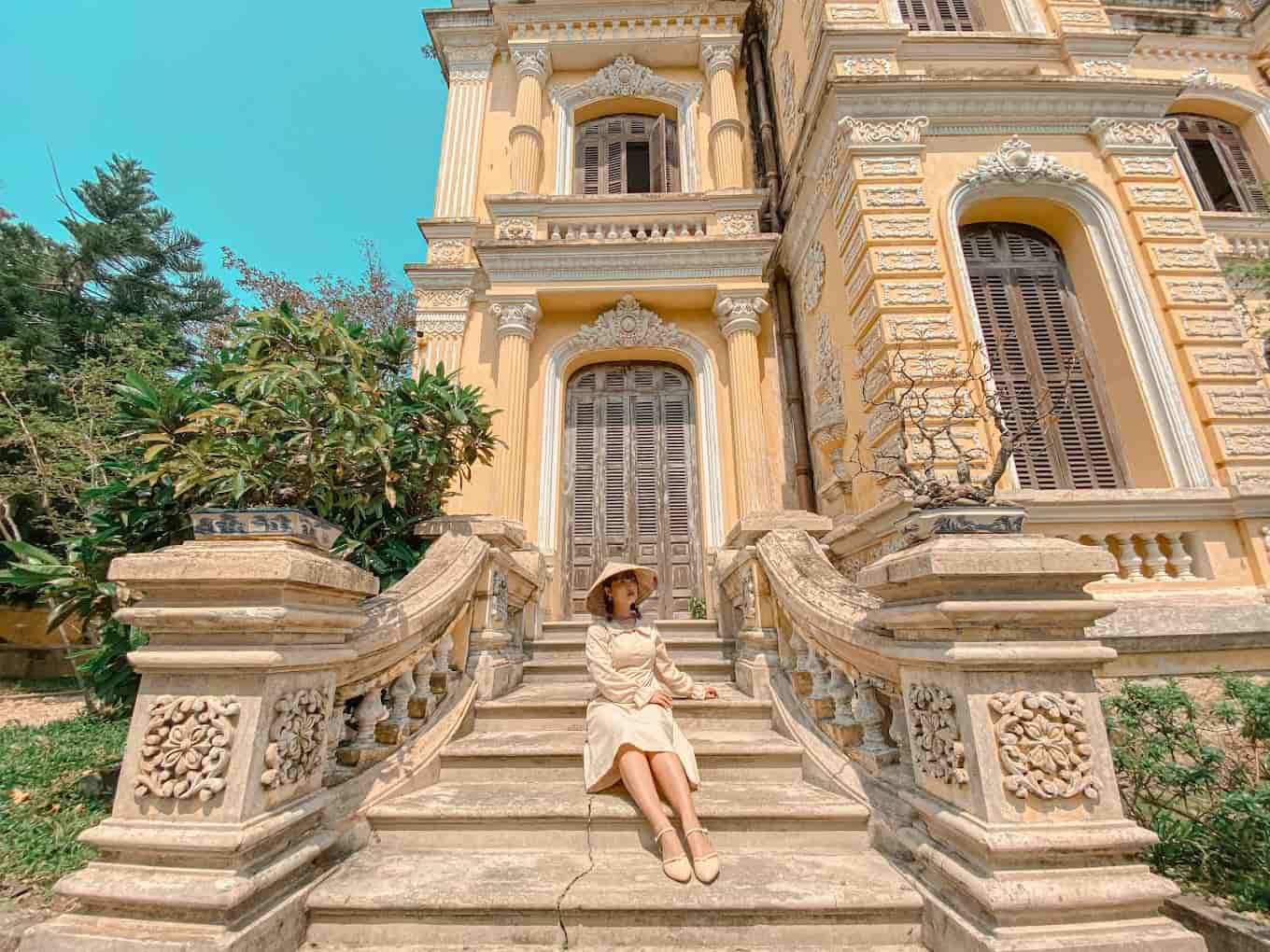
Not only impressive in its exterior design, but Khai Tuong Pavilion is also intricately decorated with various new materials. Notable highlights include high-value wall paintings and the furnishings on the first floor. The entrance hall stands out with six wall paintings on wooden panels, adorned with carved lotus and apricot blossom motifs, creating a beautiful sight. Though they don’t share the same theme, one can easily recognize that they depict the tombs of the five kings (except for the sixth painting). The combination of traditional and Western decorative elements creates an incredibly impressive space.
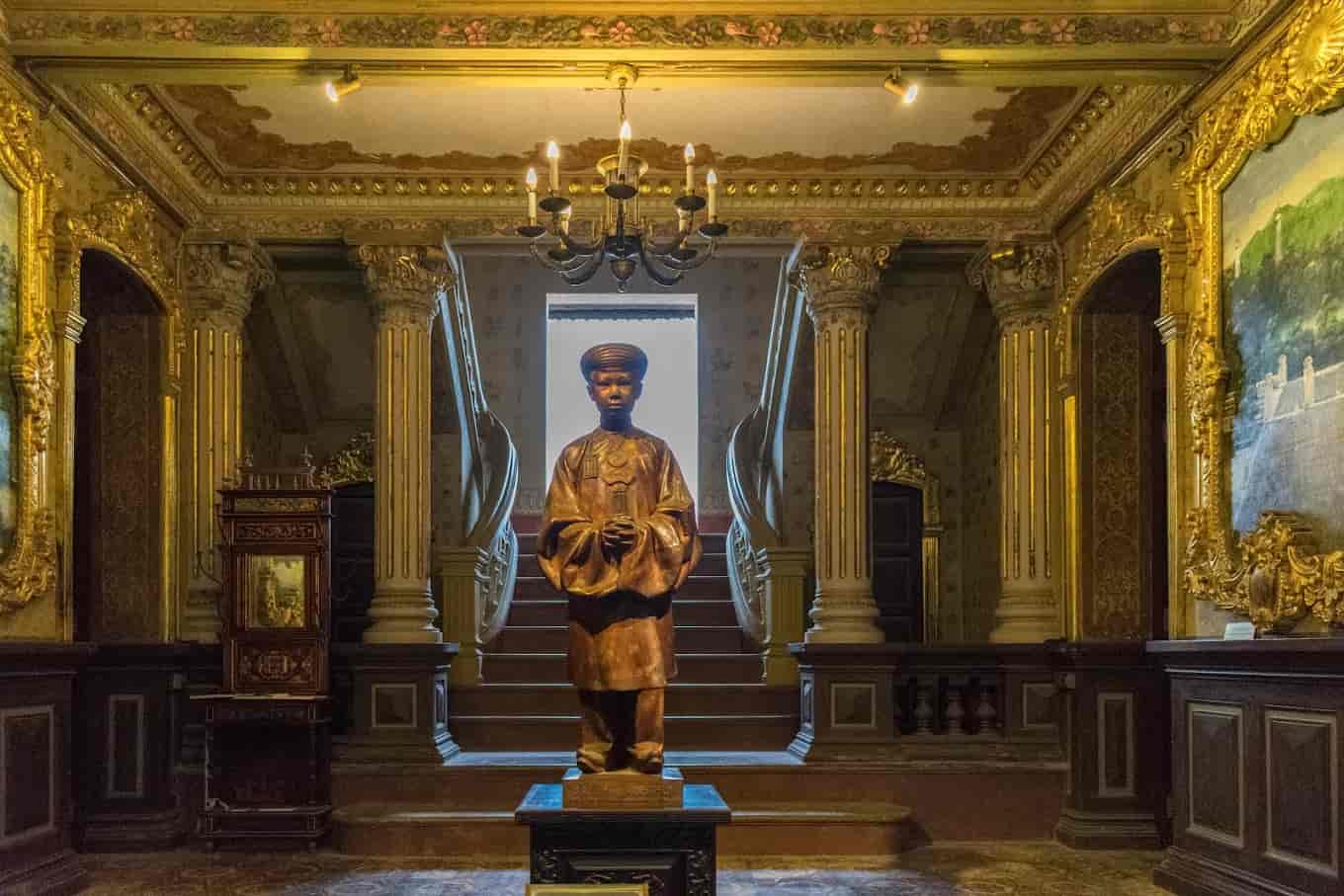
Should you visit An Dinh Palace when traveling to Hue?
As a remarkable and prominent construction of the Nguyen Dynasty, An Dinh Palace possesses a favorable location with a serene and cool ambiance. However, in the past, it didn’t attract much attention and wasn’t well-known, even though it has been open to tourists for a long time. It has only gained significant popularity among young people in recent times.
Especially after its appearance in the movie “Gái Già Lắm Chiêu” and the music video of Hoa Minzy, the number of visitors to the palace has increased significantly. If you haven’t visited it yet, this time when you come to Hue, don’t forget to spend time exploring it. Besides its unique architectural style, An Dinh Palace also holds many fascinating stories and historical stages that have been preserved here. Many people come here to witness the beauty of the palace in real life, which is different from what they saw on the screen.
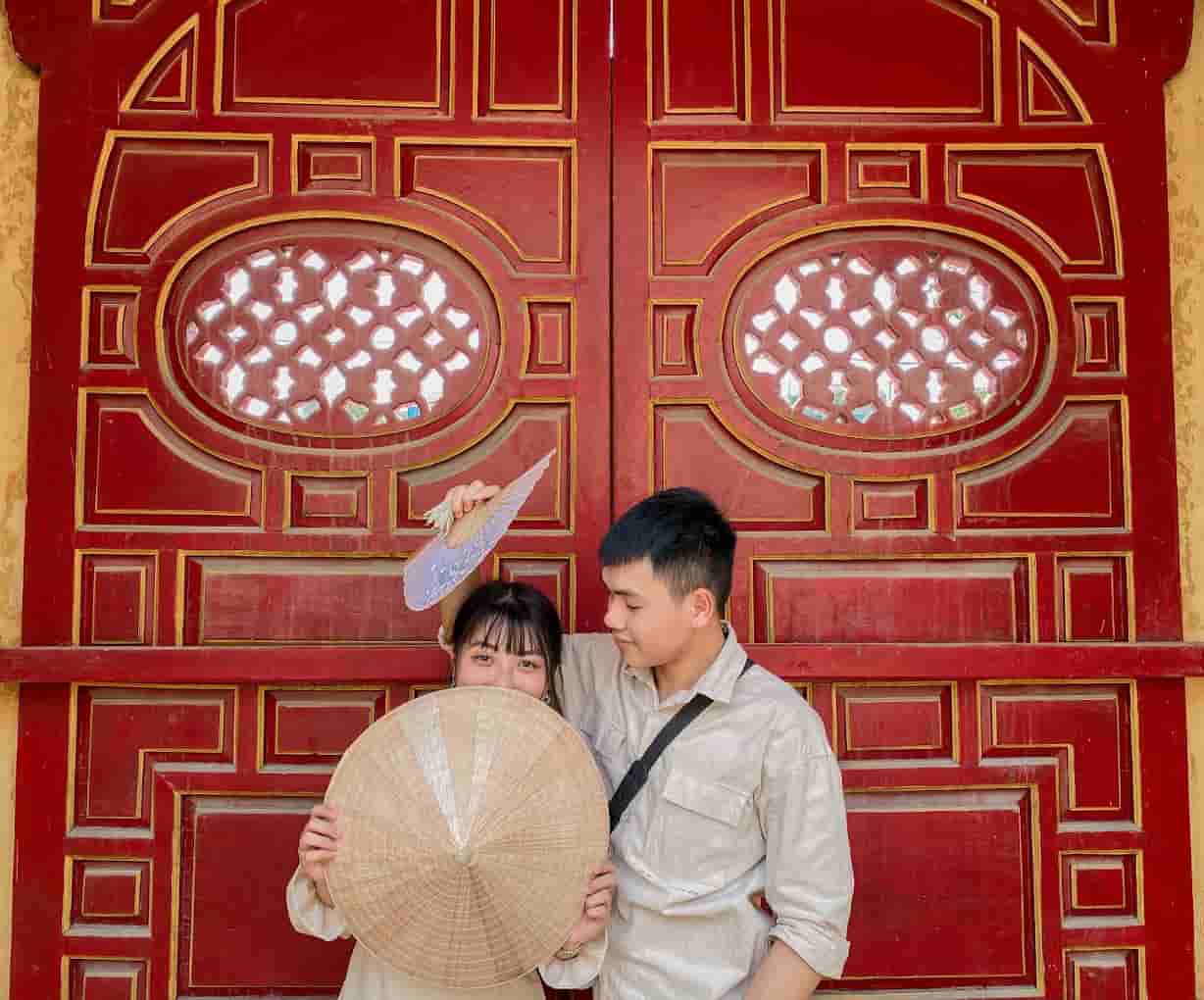
With its impressive architecture, An Dinh Palace also offers picturesque scenes full of poetic charm. The tranquil and ancient atmosphere, along with the pristine nature, creates a peaceful space, making it a popular “hot hit” check-in spot for young people visiting Hue. It provides unique and familiar “Instagrammable” corners that everyone enjoys. Therefore, it would be a missed opportunity if you skip this destination!
Information for visiting An Dinh Palace in Hue.
Ticket price for An Dinh Palace.
Like other historical sites, every tourist who wants to visit this palace must buy a ticket. Specifically, the ticket price for An Dinh Palace is 30,000 VND for adults, and children can enter for free. Tickets are available for purchase at the entrance of the historical site. Additionally, you can opt for a combo ticket that allows you to explore multiple historical sites for the price of 580,000 VND per adult and 110,000 VND per child.
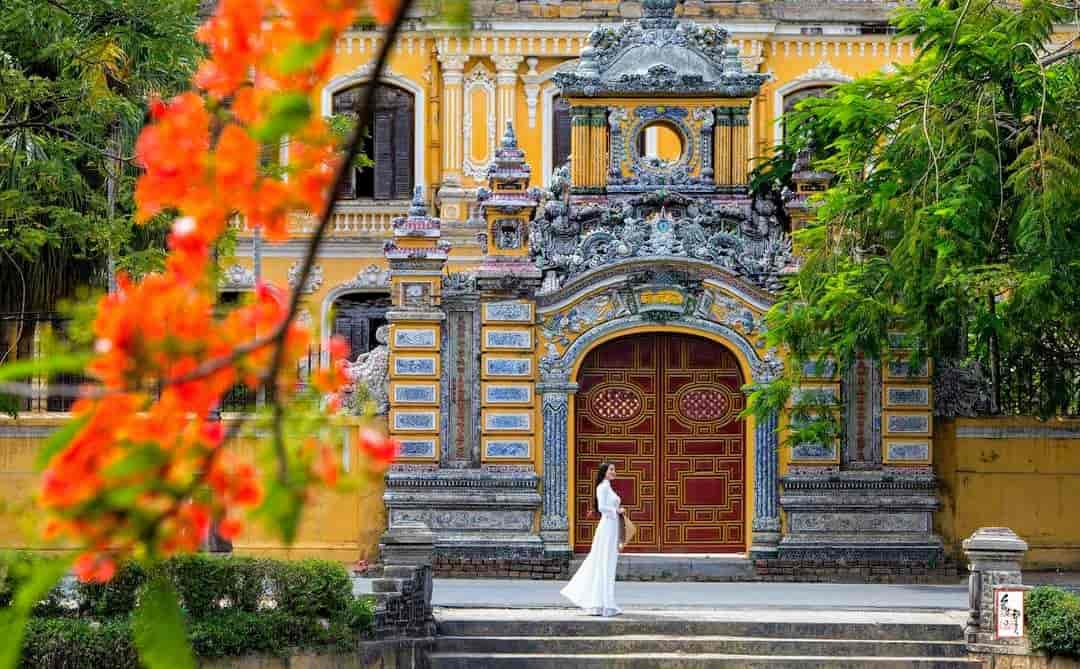
Opening hours of An Dinh Palace.
The opening hours of An Dinh Palace are essential to consider when planning your visit. Keeping track of this information helps you organize your time and create a specific itinerary. To cater to the needs of tourists, the palace has two designated time frames as follows:
- Summer opening hours: from 6:30 AM to 5:30 PM.
- Winter opening hours: from 7:00 AM to 5:00 PM.
Food and beverages during the visit to An Dinh Palace.
After exploring and taking photos to your heart’s content at the palace, you can enjoy Hue’s traditional cuisine. There are plenty of restaurants and eateries around the area offering the characteristic flavors of this dreamy city, such as bun bo, com hen, bun hen, and banh canh. However, if you are a fan of Hue-style cakes, don’t miss the An Dinh Palace Bánh Bèo – Nam – Loc stall at 1148 Nguyen Hue Street (right next to the palace). The Bánh Bèo of An Dinh Palace is renowned for its delicious taste, and you’re sure to love it.
Things to note when exploring An Dinh Palace in Hue.
With the popularity of An Dinh Palace, you must be planning a trip there, right? But before you go, here are a few things to keep in mind. Unlike natural landmarks, the historical sites in Hue have stricter regulations.
- Even though the palace is located quite centrally, it’s a good idea to take some time to review the map, directions, and location of the historical site to avoid getting lost.
- Avoid wearing inappropriate clothing such as shorts, short dresses, tank tops, off-shoulder outfits, or any revealing attire. This shows a lack of respect and etiquette.
- An Dinh Palace doesn’t restrict the amount of time you can spend there, meaning you can take your time. However, do pay attention to maintaining cleanliness and preserving the beauty of the surroundings, and avoid littering.
- Absolutely refrain from touching artifacts or scribbling on walls and objects within the palace to preserve the landscape and its beauty.
- Additionally, tourists should keep an eye on the weather conditions and choose a suitable time to visit, avoiding days with heavy rain, and bring along essential items, especially a camera and a phone to take photos.
Some places around An Dinh Palace that you can explore further.
If you have ample time in Hue and want to explore more places, after leaving An Dinh Palace, you can visit the following places (if you haven’t already).
Imperial City – Hue Citadel (2.8 km).
The Imperial City, also known as Hue Citadel or the Imperial Palace, is a famous tourist attraction and a masterpiece of Nguyen Dynasty’s high-level architecture. It was built hundreds of years ago and used to be the residence of kings and the royal family.
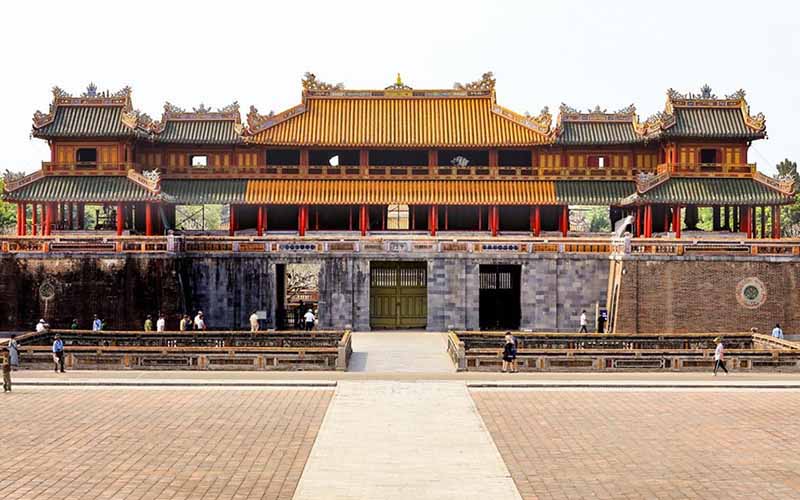
With its vast space and well-arranged layers, it showcases over 100 magnificent architectural structures, giving you an overview of the glorious past of the nation. Besides, you can admire exceptional artworks and participate in various fascinating experiences.
Perfume River – Truong Tien Bridge (2 km).
Both the Perfume River and Truong Tien Bridge are symbols of the ancient capital Hue. From An Dinh Palace, it’s just about a 2 km journey to this area. Its picturesque scenery has left a lasting impression on countless first-time visitors to this dreamlike land. Truong Tien Bridge stretches across the peaceful Perfume River, connecting the South and North banks. It serves not only the transportation needs of the locals but also offers a vantage point to admire the city’s landscape and the tranquil Perfume River. This place is also a favorite spot for many young people’s “insta-worthy” photos.
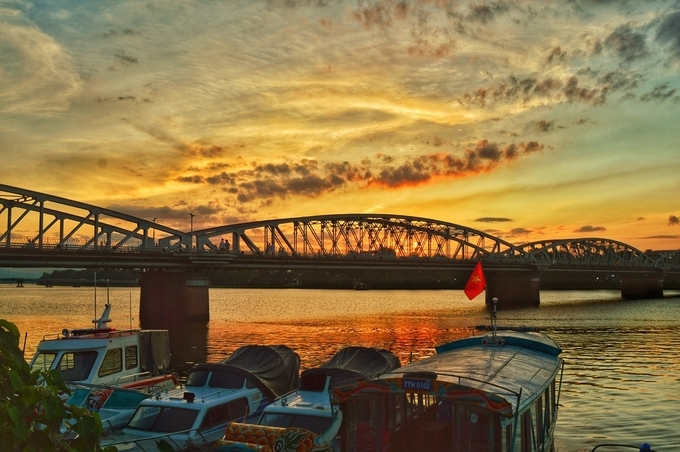
Thien Mu Pagoda (4.5 km).
Heading a bit further to the North, along the banks of the Perfume River, you will reach Thien Mu Pagoda – a famous and sacred pagoda. Thien Mu Pagoda, also known as Linh Mu Pagoda, is located on Ha Khe Hill and was built in 1601 during the reign of King Nguyen Hoang. Here, you can find prominent structures such as Phuoc Duyen Tower, Quan Am Shrine, Dai Hung Palace, etc. The ancient and picturesque surroundings add to the charm of this spiritual place.

It can be said that An Dinh Palace is a perfect blend of Vietnamese and European architectural art, creating an impressive architectural landscape. It is easy to understand why it has been chosen for film production and music videos. Until now, the palace has truly become a must-visit destination for everyone coming to Hue. Finally, VN Car Rentals wishes you, your friends, and family a great time exploring An Dinh Palace.



[…] An Dinh Palace is a tourist destination in Hue facing the Perfume River. The surrounding area only includes thick walls and bricks. When first built, An Dinh Palace contained 10 structures, but due to erosion over time and war damage, only 3 structures remain today. […]